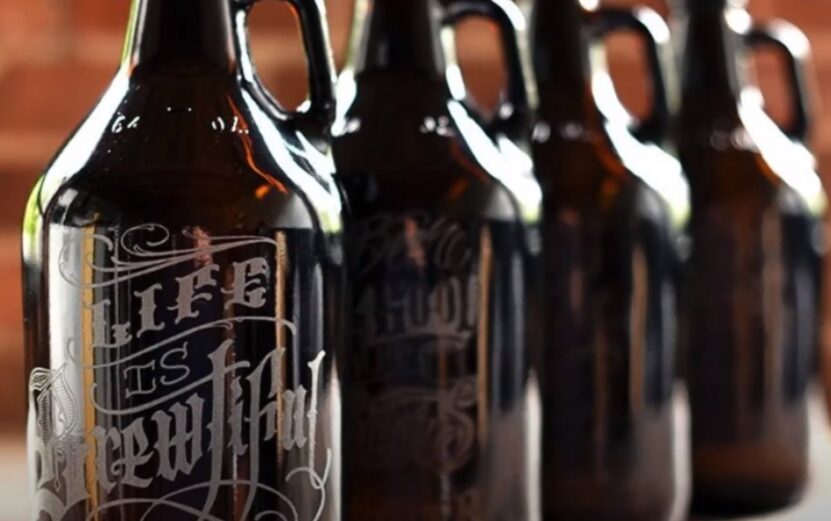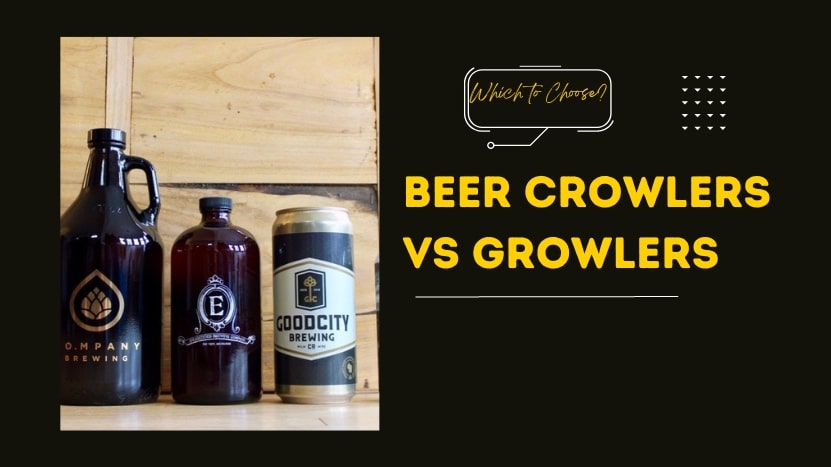Have you ever found yourself standing in a brewery or liquor store, contemplating whether to take home your favorite craft beer in a growler or crowler? If so, you’re not alone.
The beer container you choose might seem like a trivial decision, but it can significantly influence your beer drinking experience. This article is designed to provide an in-depth comparison between beer crowlers and growlers, two popular containers that craft beer enthusiasts frequently use.
Beer Crowlers: What Are They and How Do They Work?
Crowlers have been revolutionizing the craft beer industry since their inception. In simple terms, a crowler is a giant beer can, typically holding 32 ounces (around 946ml) of your favorite brew. These one-use, sealable containers are filled and sealed on-site at your local brewery, allowing you to take fresh, draft-quality beer right to your home.
The beer-filling process for crowlers is quite similar to growlers, but with a distinct advantage. Beer poured into crowlers undergoes less exposure to oxygen, thus maintaining its taste, aroma, and carbonation for a longer period.
Once the crowler is filled, a specialized machine hermetically seals the can, ensuring minimal oxygen exposure and maximum beer freshness.
Crowlers, being made of aluminum, are lightweight and robust, making them perfect for on-the-go beer lovers. They are also opaque, protecting your beer from harmful light exposure, which can degrade the beer quality over time. Crowlers, in essence, provide a practical and reliable solution for transporting and preserving craft beer.
Growlers: A Classic Choice for Craft Beer Enthusiasts

On the other side of the beer container spectrum, we have the growler – a classic choice steeped in tradition. Growlers are typically made from glass, ceramic, or stainless steel, with the most common sizes being 64 ounces (around 1893ml). They feature a handle for easy carrying and a resealable cap to maintain the beer’s freshness.
The joy of growlers lies in their reusable nature. Unlike crowlers, which are single-use, growlers can be brought back to the brewery for refills, making them a regular part of a beer enthusiast’s toolkit. They’ve been an integral part of the beer community long before crowlers came into the picture, and their charm and practicality keep them in high demand today.
One potential downside of growlers, particularly glass ones, is their transparency. Exposure to light can negatively affect beer quality. However, this can be mitigated by opting for darker glass, ceramic, or stainless steel growlers. Although a bit heavier than crowlers, the larger capacity and reusability of growlers make them a favored choice for many.
Comparing the Capacities
When it comes to capacity, the crowler and growler serve different purposes. A crowler’s 32-ounce capacity is excellent for individual consumption or small gatherings, as it typically equates to two to three servings of beer. They’re perfect when you want to sample a variety of beers without committing to a large quantity.
Growlers, on the other hand, offer more considerable capacity, typically twice that of a crowler. Their 64-ounce size is ideal for larger gatherings or for those who’ve found a beer they truly love and want to savor over a few days. A growler can comfortably provide five to six servings, depending on your pour size.
In terms of sheer versatility, some breweries offer mini growlers, or “howlers,” which match the crowler’s 32-ounce capacity. This way, beer lovers can enjoy the benefits of a growler without committing to a larger volume. Remember, once opened, beer in both crowlers and growlers should ideally be consumed within a day to maintain its freshness and carbonation.
Which Container is Easier to Transport?

When it comes to portability, crowlers are generally easier to handle. Their lightweight aluminum structure and compact design make them a great choice for outdoor activities such as picnics, camping, or beach trips. Plus, they’re not breakable, adding to their travel-friendly nature.
Growlers, in contrast, require more careful handling. While their handle makes carrying easy, their heavier weight and the larger size can make transportation a bit more challenging. Glass growlers, in particular, require caution as they’re susceptible to breakage. However, stainless steel or ceramic growlers are sturdier and can withstand travel better.
The decision ultimately rests on your needs. If you’re heading out for a short trip or want to sample different beers, a crowler might be a more suitable choice. For longer stays or larger parties, a growler’s larger capacity could be more beneficial, provided you can transport it safely.
Freshness and Shelf Life
Freshness and shelf life are critical when choosing between a crowler and growler. Crowlers, thanks to their hermetic sealing process, can keep beer fresh for several weeks, provided they remain unopened. Once opened, the beer should ideally be consumed within a day to enjoy its optimal taste and carbonation.
Growlers, on the other hand, can maintain beer freshness for about a week, although it’s best to consume the beer within a few days of opening. Since growlers use a cap-sealing mechanism rather than a machine-sealed lid, there is a slightly higher risk of oxygen exposure, which can affect beer quality.
However, both crowlers and growlers outperform traditional beer cans and bottles when it comes to freshness. Their direct-from-the-tap approach ensures you get brewery-fresh beer, making either choice a win for freshness.
Customization and Labeling

Another exciting aspect of choosing between crowlers and growlers is the ability to customize and label them. Crowlers offer plenty of space for creative and informative labels. Breweries often use this space to provide details about the beer, branding, and even regulatory information. Plus, the can’s surface can serve as a canvas for beautiful artwork and designs.
Growlers, particularly glass ones, offer less real estate for detailed labels due to their shape and the reusability factor. However, they provide a classic and elegant aesthetic. Many breweries and consumers appreciate the old-school charm of a logo etched or embossed onto a glass, ceramic, or stainless-steel growler.
In both cases, the customization and labeling add to the experience of buying and consuming craft beer. It offers a sense of connection to the brewery and the artistry behind the beer.
Which Option is More Sustainable?
When discussing crowlers and growlers, sustainability is an important consideration. Growlers, due to their reusable nature, typically have a smaller environmental footprint. You can use the same growler repeatedly, reducing waste generated by single-use containers.
Crowlers, while single-use, are made from aluminum, which is one of the most recyclable materials. Therefore, if recycled properly, crowlers also represent a sustainable choice. However, it’s important to remember that not all locations may have convenient aluminum recycling facilities.
In general, both crowlers and growlers, when properly managed, represent more sustainable options than traditional beer cans and bottles, contributing positively to the growing green initiative within the craft beer industry.
Cost Considerations

In terms of cost, crowlers tend to be cheaper than growlers, primarily because they’re smaller and made from less expensive material. However, since they’re single-use, the cost can accumulate over time, particularly for regular beer drinkers.
Growlers involve a higher upfront cost, especially if you opt for a ceramic or stainless-steel variant. However, their reusable nature can make them a more cost-effective choice in the long run, provided you take care of them and use them frequently.
Remember that the cost also includes the price of the beer itself, which can vary based on the brewery and the specific beer type. It’s essential to consider both the container and beer cost when choosing between a crowler and growler.
How Crowlers and Growlers Enhance Brewery Visits
Visiting a brewery is an immersive experience, allowing you to understand the craft and passion behind each brew. Crowlers and growlers play a key role in this experience. They allow you to bring a piece of that experience home straight from the tap.
With crowlers, you can take home multiple beers in manageable quantities, perfect for sampling various brews. On the other hand, growlers allow you to bring home a larger quantity of your favorite brew, extending the brewery experience over several days.
Both crowlers and growlers contribute to the charm of a brewery visit. They offer a tangible connection to the brewery, adding a personal touch to the craft beer experience.
The Verdict: Choosing Between Beer Crowlers and Growlers
The choice between crowlers and growlers depends largely on your individual needs and preferences. If you prefer a lightweight, portable container and want to sample different beers, a crowler might be the best option. Its better preservation of freshness can also be a winning factor if you plan to store the beer for a few weeks.
Conversely, if you’re seeking a reusable container for larger quantities of beer, a growler is an excellent choice. While they require more careful handling, the charm and tradition of growlers are undeniable. They’re perfect for beer enthusiasts who have a favorite brew they like to enjoy over time.
Regardless of your choice, both crowlers and growlers offer a fresh-from-the-brewery experience that traditional beer cans and bottles can’t match.
Closing Thoughts
The world of craft beer is an exciting journey, and the choice between crowlers and growlers is just one part of it. Both options have their unique merits, and the best choice depends on your personal preferences, the situation, and the beer you want to enjoy.
Whether you’re a casual beer drinker or a dedicated enthusiast, understanding the differences and advantages of crowlers and growlers can greatly enhance your craft beer experience. So the next time you find yourself in a brewery or liquor store, you’ll be well-equipped to make the best choice for your craft beer journey.

